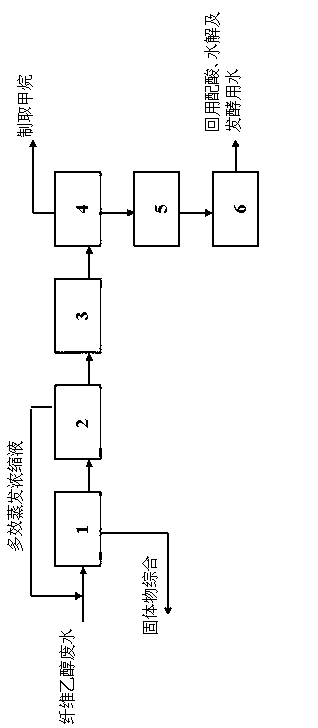Treatment method for wastewater generated in cellulosic ethanol production
A technology of cellulosic ethanol and its treatment method, which is applied in the field of cellulosic ethanol wastewater treatment, can solve problems such as environmental protection constraints, and achieve the effect of saving water and reducing sewage discharge
- Summary
- Abstract
- Description
- Claims
- Application Information
AI Technical Summary
Problems solved by technology
Method used
Image
Examples
Embodiment 1
[0028] The treatment method of the present invention is used to treat the waste water of a domestic medium-scale test-scale cellulosic ethanol production plant. The device uses corn stalks as raw materials, and mainly uses steam acid explosion pretreatment, enzymatic hydrolysis, sugar solution fermentation, ethanol concentration and rectification purification to produce cellulosic ethanol. The main pollutant COD in wastewater is 129050 mg / L ( Chromium method, the same below), BOD 5 68600 mg / L, sulfate radical 9290 mg / L, total salt content 9.69%, ammonia nitrogen 38.8 mg / L, carboxylic acid 4600 mg / L, furan 230 mg / L, phenol 600 mg / L.
[0029] Adopt the pressure filtration-multi-effect evaporation-cooling-anaerobic fermentation-aerobic biology-filtration combined treatment of the present invention to carry out laboratory treatment test to above-mentioned waste water, the scale of waste water treatment is 200 mL / h, the main experimental device constitution of each treatment unit ...
Embodiment 2
[0034] The treatment device of Example 1 was used to treat the same sewage as in Example 1, and the wastewater treatment effects obtained by changing the operating conditions of each treatment unit are shown in Table 2.
[0035] Table 2 Main processing unit composition and processing effect of embodiment 2
[0036] Handling unit name Processing device scale and main components Main operating conditions and control parameters Treatment effluent or effect 1 filter press Filter, processing capacity 10L / h Intermittent operation, vacuuming, membrane filtration; add 50mg / L polyferric sulfate flocculant to the wastewater before pressing and stirring and coagulating for 3 minutes Effluent COD105,000 mg / L; filter residue moisture content 75% 2 Multi-effect evaporation Falling film five-effect evaporation test device, made of glass. The wastewater treatment scale of the device is 5L / h, mainly including evaporation column, preheater, condenser and enamel ...
PUM
 Login to View More
Login to View More Abstract
Description
Claims
Application Information
 Login to View More
Login to View More - R&D
- Intellectual Property
- Life Sciences
- Materials
- Tech Scout
- Unparalleled Data Quality
- Higher Quality Content
- 60% Fewer Hallucinations
Browse by: Latest US Patents, China's latest patents, Technical Efficacy Thesaurus, Application Domain, Technology Topic, Popular Technical Reports.
© 2025 PatSnap. All rights reserved.Legal|Privacy policy|Modern Slavery Act Transparency Statement|Sitemap|About US| Contact US: help@patsnap.com

